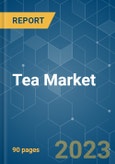The COVID-19 pandemic had a direct and unfavorable impact on the tea market globally. Global lockdowns to curb and contain the pandemic adversely affected the distribution channels. Value addition activities were affected due to disrupted distribution channels, which lowered the availability of end products in the market. The tea industry is a labor-intensive industry that has more labor involved in the process of growing and processing tea. The announcement of aggressive containments that coincided with the peak harvesting periods for quality tea leaves had affected the production of quality tea.
The tea market is characterized by the black tea segment holding a prominent share. However, the maximum growth is estimated for green and herbal/flavored tea due to the awareness of the health benefits associated with them. China is the largest producer of tea in the world, followed by India, Kenya, Sri Lanka, and others. Tea production is highly sensitive to changes in climatic conditions, as tea can only be produced in narrowly defined agro-ecological conditions. China ranks first in the global tea exports, representing approximately 31.8% of the global export of tea. China is also the leading green tea exporter.
Asia-Pacific was the largest geographic segment of the market studied. The robust economic growth in the countries has also created a large consumer base among middle-class groups with a preference for premium tea blends. Consumers are frequently enhancing their purchases from unpackaged tea to packed and bagged specialty varieties. Furthermore, the consumption of carbonated tea drinks is a new trend in the tea industry, which is further fuelling the growth of the tea market. Various tea manufacturing companies, such as Bigelow, have introduced several flavors of tea, ranging from fruity to herbal flavors, creating a diversified portfolio of tea products for customers.
Tea Market Trends
Increasing Inclination Toward Herbal and Green Tea
Consumer awareness about the health benefits of herbal and green tea may further drive the growth of the tea market. The rise in disposable income of consumers, changes in taste and preferences, and the introduction of additional healthy ingredients in tea by different market players are the other factors that fuel the market growth. The easy availability of tea is expected to encourage the growth of the Asia-Pacific green tea market. World green tea production is expected to grow at a faster rate than black tea, reflecting the growth in China. The millennials are also increasing their tea consumption, led by the promotion of tea schools and tea art training and the staging of tea expos and tea events all over the country, making it a flagship product among millennials. Owing to the increased consumption across the world, China's export of green tea has been recording steady growth. According to the ITC Trade, China's green tea export of packages lesser than or equal to 3 kg packing was valued at around USD 734.1 million in 2020 compared to USD 648.5 million in 2017. Hence, the increasing demand around the world may drive the market over the years.Asia-Pacific is Leading the Tea Market
Currently, the growth in tea consumption is being driven by rapid growth in per capita incomes, particularly in the developing countries of Asia-Pacific. A growing, increasingly urban young population segment entering the middle class is prepared to consume more and pay for premium tea products. Therefore, these changes have the potential to develop into stronger and longer trends. At present, Asia-Pacific has the largest market for tea consumption, with robust economic growth in a number of developing countries, such as China and India. This has created a large middle-class group, with a preference for premium tea blends and brands, often upgrading their purchases from unpackaged tea to packed and bagged specialty varieties.Tea Market Competitor Analysis
Additional benefits of purchasing the report:
- The market estimate (ME) sheet in Excel format
- 3 months of analyst support
This product will be delivered within 2 business days.










